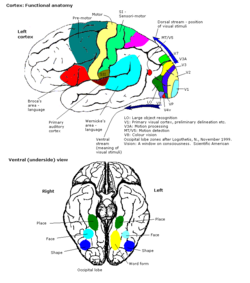Colour centre
| Colour centre | |
|---|---|

Colour vision area shown as V8 on upper image
|
|
|
Anatomical terminology
[]
|
The colour centre is a region in the brain primarily responsible for visual perception and cortical processing of colour signals received by the eye, which ultimately results in colour vision. The colour centre in humans is thought to be located in the ventral occipital lobe as part of the visual system, in addition to other areas responsible for recognizing and processing specific visual stimuli, such as faces, words, and objects. Many functional magnetic resonance imaging (fMRI) studies in both humans and macaque monkeys have shown colour stimuli to activate multiple areas in the brain, including the fusiform gyrus and the lingual gyrus. These areas, as well as others identified as having a role in colour vision processing, are collectively labelled visual area 4 (V4). The exact mechanisms, location, and function of V4 are still being investigated.
The primary part of the visual cortex, (V1), is located in the calcarine sulcus, and is the first cortical area involved in visual processing. It receives visual input from the lateral geniculate nucleus, which is located in the thalamus. V1 sends the visual information received from the LGN to other extrastriate cortex areas for higher order processing. This higher order processing includes the recognition of shapes, motion, and colour.
V1 has multiple areas that are colour-sensitive, which indicates that colour processing is not limited to one area. According to a paper by Dr Robert Shapley, V1 has an important role in colour perception. fMRI experimental results showed that V1 has two kinds of colour sensitive neurons: single-opponent and double-opponent cells. These cells are integral in the opponent process of interpreting colour signals. Single-opponent neurons respond to large areas of colour. This is advantageous for recognizing large colour scenes and atmospheres. In comparison, double opponent cells respond to patterns, textures, and colour boundaries. This is more important for perceiving the colour of objects and pictures. The double-opponent cells are receptive to opposite inputs from different cone cells in the retina. This is ideal for identifying contrasting colours, such as red and green. [1] Double-opponent cells are particularly important in computing local cone ratios from visual information from their receptive fields.
...
Wikipedia
